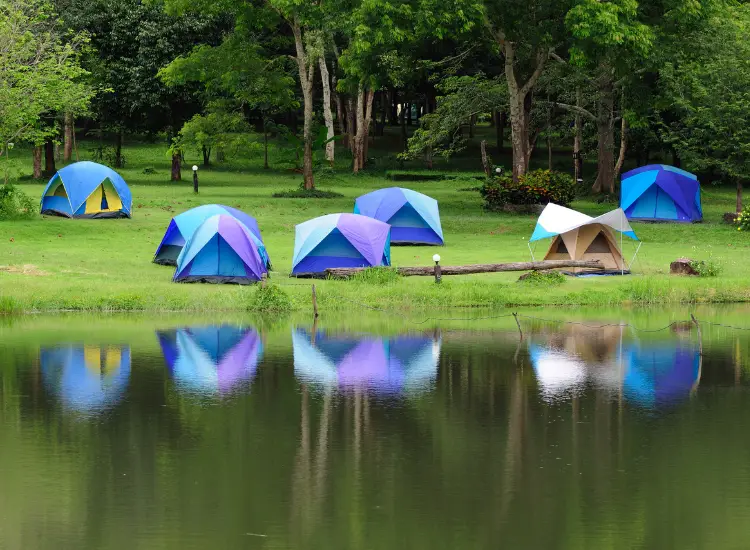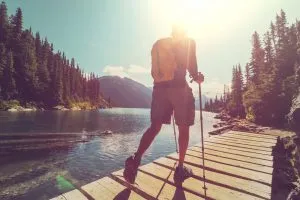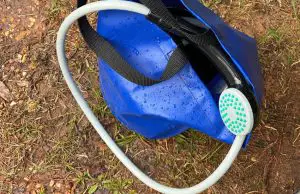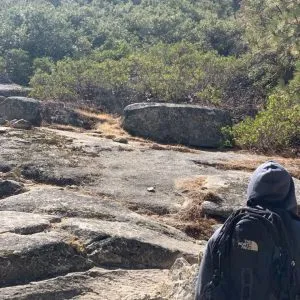What Is Stealth Camping? (Discover the Thrill of Undetected Camping)

What is stealth camping? Have you ever wondered what it would be like to embark on a camping adventure without being noticed? Stealth camping is a unique form of camping that involves setting up camp in areas where it may not be permitted or going unnoticed by others. It’s a thrilling and adventurous way to connect with nature and explore new places.
Stealth camping requires a certain level of skill and preparation. From finding the perfect secluded spot to setting up camp discreetly, there are many factors to consider. While it’s important to be respectful of private property and follow local regulations, stealth camping can be a way to experience the great outdoors in a more unconventional way.
In this article, we’ll delve into the world of stealth camping, exploring its ins and outs, sharing tips and tricks, and discussing the ethical considerations. So if you’re curious about this unconventional camping style and want to learn more, keep reading!
Quick Links
Benefits of Stealth Camping
Freedom and Flexibility
Stealth camping offers a sense of freedom and flexibility that traditional camping may not provide. With stealth camping, you have the ability to camp in various locations, even in areas where camping might typically be prohibited. This allows you to explore and experience new surroundings without being limited to designated camping areas.
Privacy and Solitude
Stealth camping allows you to enjoy privacy and solitude in nature. By camping in lesser-known or secluded areas, you can escape from crowded campsites and noisy campers. This solitude provides a peaceful and relaxing experience, allowing you to truly connect with nature and enjoy the tranquility of your surroundings.
Closer Connection with Nature
Stealth camping often takes you off the beaten path and into unexplored areas of nature. This provides a unique opportunity to immerse yourself in the beauty of the natural world. You can wake up to the sounds of chirping birds, fall asleep under a sky filled with stars, and truly appreciate the sights, sounds, and smells of the great outdoors.
Cost Savings
Stealth camping can be a cost-effective alternative to traditional camping. By avoiding established campgrounds or paying camping fees, you can save money during your outdoor adventures. This makes stealth camping a budget-friendly option for those who want to enjoy nature without breaking the bank.
Adventure and Thrill
Stealth camping adds a sense of adventure and thrill to your camping experience. The excitement of finding a hidden campsite, staying undetected, and exploring unfamiliar surroundings can be incredibly rewarding. It allows you to step outside of your comfort zone and embrace the thrill of the unknown.
Tips for Finding Suitable Stealth Camping Spots
Stealth camping can be an exciting and adventurous way to experience the outdoors, but finding suitable camping spots can sometimes be a challenge. Here are some tips to help you locate the perfect stealth camping spot for your next outdoor adventure:
- Research your destination: Before heading out, research the area you plan to visit to understand any regulations or restrictions related to camping. Look for areas with minimal or no restrictions where stealth camping may be possible.
- Be aware of private property: It’s important to respect private property boundaries and avoid trespassing. Stay on public lands or seek permission from landowners if you wish to camp on private property.
- Choose low-traffic areas: Look for camping spots away from heavily frequented trails or popular camping areas. By camping in less-traveled areas, you can reduce the risk of being discovered.
- Look for natural barriers: Seek out spots that offer natural barriers or obstacles to provide additional concealment and privacy. These can include dense vegetation, large rocks, or hilly terrain.
- Consider noise and light: Avoid camping near areas with high levels of noise or sources of bright light, as these can increase the chances of being detected.
- Leave no trace: Practice Leave No Trace principles to minimize your impact on the environment and avoid drawing attention to your campsite. Pack out all trash and avoid leaving any signs of your presence.
- Be prepared to be stealthy: Plan your camping activities to minimize noise and visible signs of camping, such as campfires. Use low-profile tents and avoid excessive movement or loud conversations that may attract attention.
By following these tips and using your discretion when selecting stealth camping spots, you can enjoy a thrilling and undetected camping experience while preserving the natural beauty of the outdoors.
Essential Gear for Stealth Camping
Stealth camping requires careful planning and the right gear to ensure a successful and enjoyable experience. Here are some essential items to consider when planning your stealth camping adventure:
- Tent: Choose a lightweight, compact tent that is easy to set up and pack away quickly.
- Sleeping Bag: Definitely go for a sleeping bag that is suitable for the weather conditions you will encounter during your stealth camping trips.
- Sleeping Pad: A comfortable sleeping pad will provide insulation and cushioning for a good night’s sleep.
- Camping Stove: A portable camping stove is essential for cooking your meals discreetly in the wilderness.
- Cookware and Utensils: Pack lightweight and durable cookware and utensils for your cooking needs.
- Water Filtration System: Ensure access to clean drinking water by bringing a portable water filtration system.
- Headlamp: A headlamp will come in handy for navigating in the dark and performing tasks around your campsite.
- Multi-tool or Pocket Knife: A versatile multi-tool or pocket knife can be useful for a variety of tasks in the outdoors.
- First Aid Kit: Be prepared for minor injuries and emergencies with a compact and well-stocked first aid kit.
- Navigation Equipment: Bring a map, compass, or GPS device to help navigate your way through unfamiliar terrain.
- Portable Toilet: Consider bringing a portable toilet system to ensure proper waste disposal during your stealth camping trips.
Remember to pack light and only bring the essentials to minimize your impact and maintain a low profile while enjoying the thrill of stealth camping.
Preparation and Planning for Stealth Camping
Choosing the Right Location
One of the key aspects of stealth camping is finding the right location. Look for secluded areas away from designated campsites and popular hiking trails. Consider factors such as privacy, safety, and terrain when selecting a spot.
Minimal Gear and Equipment
When stealth camping, it is crucial to pack light and bring only essential gear. Opt for lightweight and compact equipment that can be easily carried and concealed. Avoid unnecessary items that may increase the risk of being detected.
Camouflage and Disguise
Blend in with your surroundings by using camouflage and taking steps to disguise your campsite. Choose gear and clothing that matches the natural environment and minimize any visible traces of your presence.
No Trace Camping
Practice Leave No Trace principles to minimize your impact on the environment and avoid detection. Pack out all trash, minimize noise, and leave the campsite exactly as you found it to avoid arousing suspicion or attracting attention.
Timing and Noise Control
Be mindful of the time you arrive and depart from your stealth camping spot. Arriving late and leaving early can reduce the chances of being noticed. Furthermore, control noise levels during your stay to avoid drawing attention to your campsite.
How to Set Up Camp Stealthily
Here are some tips to help you set up camp undetected:
- Choose a secluded location: Look for isolated areas away from popular hiking trails or well-known camping spots. Ideally, find a spot that offers natural cover, such as trees or rocks, to conceal your presence.
- Arrive late and leave early: To minimize the chances of being spotted, arrive at your camping location during the later hours of the day and leave early in the morning.
- Keep noise to a minimum: Avoid loud conversations or activities that could draw attention to your campsite. Be mindful of the volume of your voice and any music or noise-making devices.
- Use non-reflective gear: Choose camping gear and equipment that doesn’t reflect light. This can help you blend in with the surroundings and reduce the chances of being noticed by others.
- Leave no trace: Practice Leave No Trace principles by minimizing your impact on the environment. Pack out all your trash, bury human waste properly, and avoid leaving any visible signs of your campsite.
- Keep fires small and hidden: If you decide to have a campfire, keep it small and try to conceal it from view. Use existing fire pits whenever possible, or consider using a small camping stove instead.
- Be respectful of private property: Always ensure that you’re camping on public land or have obtained the necessary permissions. Respect any posted signs or private property boundaries.
- Practice situational awareness: Keep an eye out for other campers or hikers nearby. If you notice someone approaching your campsite, be prepared to relocate or adjust your plans accordingly.
- Stay flexible and adaptable: Stealth camping can sometimes require you to adjust your plans on the go. Be prepared to change locations or adapt your camping strategy based on the circumstances.
Remember, stealth camping may not be permitted in all areas, so be sure to research local regulations, permits, and guidelines before embarking on your outdoor adventure. Always prioritize your safety and the preservation of nature while enjoying the thrill of undetected camping.
Minimizing Environmental Impact while Stealth Camping
When engaging in stealth camping, it is important to be mindful of the impact we have on the environment. By following certain practices and being responsible campers, we can minimize our ecological footprint and preserve the natural beauty of our surroundings. Consider the following strategies for minimizing environmental impact while stealth camping:
Leave No Trace Principles
Familiarize yourself with the principles of Leave No Trace, which provide a framework for responsible outdoor recreation. These principles include minimizing campfire impacts, properly disposing of waste, respecting wildlife and habitats, and leaving natural and cultural artifacts undisturbed. Following these principles ensures that future campers can enjoy the same pristine environment.
Choose Dispersed Camping Areas
Instead of camping in established campgrounds, consider dispersed camping areas that are specifically designated for low-impact camping. These areas often have minimal infrastructure and allow campers to immerse themselves in nature while minimizing the impact on sensitive ecosystems.
Practice Leave No Trace Cooking
When cooking during stealth camping, utilize lightweight, low-impact cooking methods such as camp stoves. Avoid building open fires, especially in areas where fire restrictions may be in place. If building a fire is necessary, use established fire rings or fire pans, and always adhere to local regulations and guidelines.
Dispose of Waste Properly
Proper waste disposal is crucial to minimize environmental impact. Pack out all trash, including food waste, and avoid burying or leaving any waste behind. Bring a portable toilet or use biodegradable waste bags to properly handle human waste and dispose of it in designated receptacles or facilities.
Respect Wildlife and Their Habitats
While stealth camping, strive to be respectful of wildlife and their habitats. Keep a safe distance from animals, observe them from afar, and avoid any actions that may disturb or harm them. Be mindful of nesting areas, breeding grounds, and sensitive habitats, and do not disturb or destroy them in any way.
Practice Leave No Trace Hygiene
Maintain good hygiene practices to minimize environmental impact. Use biodegradable soaps and shampoos when bathing in natural water sources and ensure that all products are thoroughly dispersed to prevent contamination. To prevent the spread of invasive species, clean your gear and footwear before entering and after leaving an area.
By following these practices and being responsible stewards of the environment, we can enjoy the thrill of stealth camping while minimizing our impact on the natural world.
Legal Considerations and Ethical Responsibilities of Stealth Camping
Stealth camping is an unconventional form of camping that involves camping in non-designated areas or without permission. So while it can provide a sense of adventure and freedom, it is important to be aware of the legal considerations and ethical responsibilities associated with this practice. Here are some key points to keep in mind:
- Know the laws and regulations: Before embarking on a stealth camping trip, familiarize yourself with the laws and regulations regarding camping in your chosen location. Different areas may have specific rules and restrictions, such as private property boundaries or protected lands, which should be respected.
- Leave no trace: One of the fundamental principles of ethical camping is leaving no trace of your presence. Practice Leave No Trace principles by minimizing your impact on the environment, including proper waste disposal, avoiding damage to natural resources, and leaving the campsite as you found it.
- Respect wildlife and local communities: Stealth camping should not disrupt or harm wildlife or local communities. Be mindful of your surroundings and avoid disturbing local flora and fauna. Additionally, be considerate of nearby residents or other campers by keeping noise levels down and respecting their privacy.
- Obtain necessary permissions: In some cases, stealth camping may be permissible with the landowner’s explicit permission. If you plan to camp on private property or in areas where access is restricted, obtain the necessary permissions beforehand to ensure a legal and respectful camping experience.
- Be prepared and self-sufficient: Stealth camping often means camping in remote or secluded areas, away from amenities or facilities. It is important to be self-sufficient and properly equipped with necessary provisions, tools, and knowledge to ensure your safety and wellbeing during the camping trip.
By understanding and adhering to the legal considerations and ethical responsibilities of stealth camping, outdoor enthusiasts can enjoy this unique camping experience while minimizing their impact on the environment and respecting the rights of others.
Alternative Camping Options for Those Who Want to Avoid Stealth Camping
Campgrounds and RV Parks
Campgrounds and RV parks are popular options for those who prefer designated camping areas with amenities. These locations provide designated campsites with facilities such as bathrooms, showers, and picnic tables. Campgrounds and RV parks often have specific rules and regulations, making them a suitable choice for those who want a more organized camping experience.
National and State Parks
National and state parks offer a unique camping experience amidst scenic natural landscapes. These parks provide designated campsites, often with facilities and services such as hiking trails, visitor centers, and park rangers. Camping in national and state parks allows you to enjoy the beauty of nature while adhering to park regulations and guidelines.
Private Campgrounds
Private campgrounds are another option for those who want a more controlled camping environment. These campgrounds are often privately owned and managed, offering various amenities such as electricity, water hook-ups, and recreational facilities. Private campgrounds can provide a range of options, from rustic tent sites to full-hookup RV sites, catering to different camping preferences.
Backpacking and Hiking
For outdoor enthusiasts looking for a more adventurous camping experience, backpacking and hiking can be great alternatives to stealth camping. Backpacking allows you to explore remote areas and spend the night in designated backcountry campsites. Hiking trails and overnight treks offer a chance to experience nature’s beauty while adhering to established camping regulations in wilderness areas.
Cabins and Glamping
If you prefer a more comfortable camping experience, cabins and glamping (glamorous camping) options might be ideal for you. Cabins provide a cozy shelter with amenities such as beds, kitchens, and bathrooms. Glamping offers luxurious camping setups with comfortable beds, décor, and unique accommodations. These options provide a camping feel with additional comforts and conveniences.
When considering alternative camping options, it’s important to research and plan ahead. Check availability, reservation requirements, and any specific rules or regulations for the chosen camping location. By exploring these alternatives, you can enjoy the experience of camping while still adhering to legal and designated camping areas.
Conclusion
Stealth camping offers a sense of freedom, adventure, and connection with nature that traditional camping may not provide. With the ability to camp in various locations, away from crowded campsites, stealth camping allows for privacy, solitude, and a closer connection with the natural world.
If stealth camping isn’t for you, there are plenty of alternative camping options available. Campgrounds, national parks, private campgrounds, backpacking, and glamping offer different experiences that cater to various preferences and comfort levels.
Whatever camping option you choose, the key is to enjoy the outdoors responsibly and in a way that aligns with your values and preferences. Happy camping!







